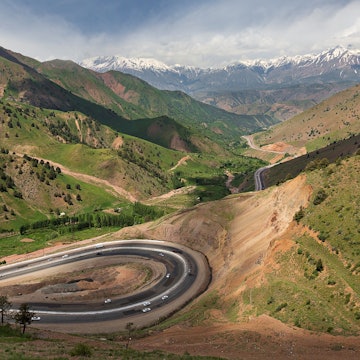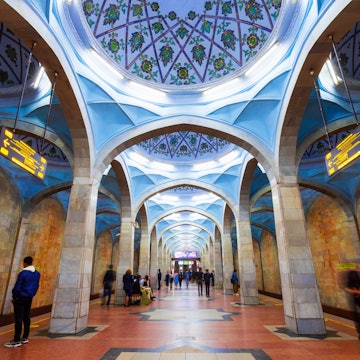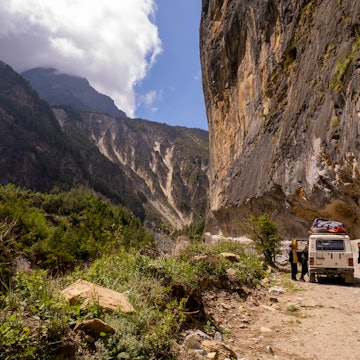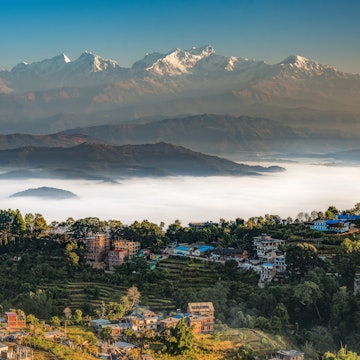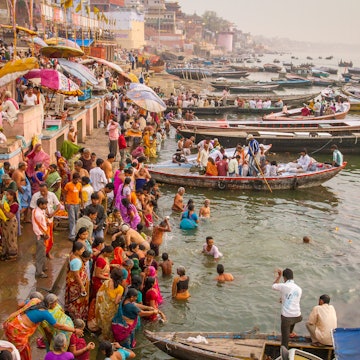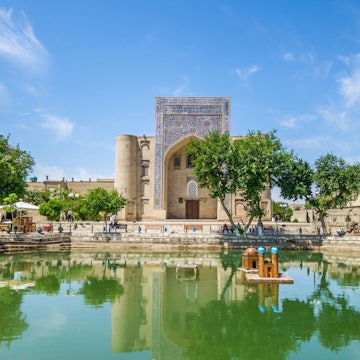
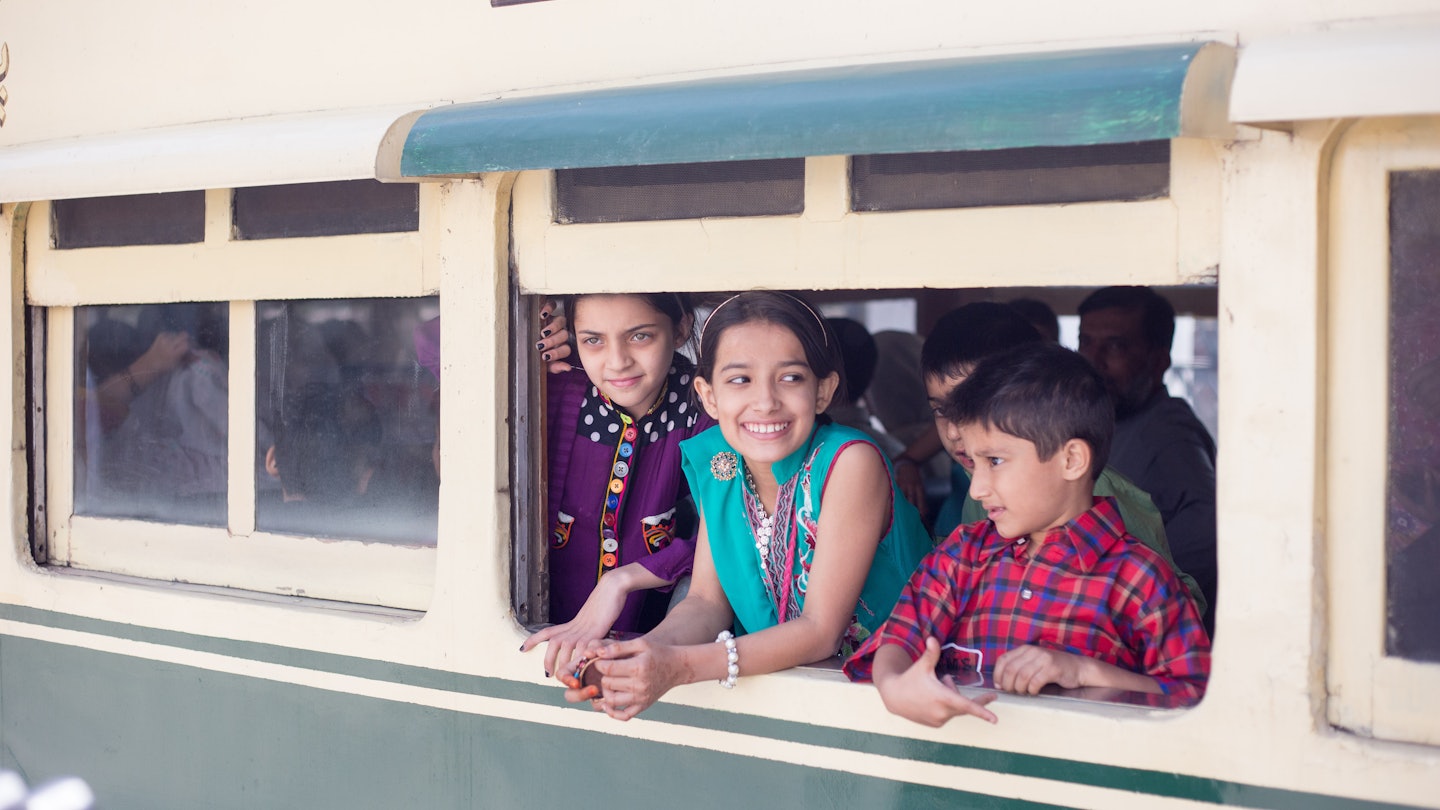
The journey may be slow but watching Pakistan's landscape unfurl as you travel by train is a magical experience © Awais khan / Shutterstock
Pakistan is one of Asia’s most exciting frontiers, but exploring independently can pose challenges, especially for those new to the country.
While public transportation is extensive, finding out about it can be difficult due to the limited amount of information online.
Planning a trip to Pakistan might seem intimidating at first, but once you understand the intricacies of the local transport system, you’ll quickly gain the confidence to travel to the most remote corners of the country. Here's everything you need to know about getting around once you arrive.
Travel by bus to hop from city to city
Numerous bus operators provide cost-effective travel between major cities. Companies such as Daewoo Express and Faisal Movers are known for their dependable service, connecting many destinations across Pakistan using large, comfortable buses. Dozens of smaller companies offer bus and van services to less frequented cities.
Larger bus companies offer online bookings – reserve your tickets through their websites (or via their apps) three or four days prior to departure. To make an online booking, you’ll need a Pakistani contact number and identity card; it's often more convenient to book through a travel agent or a local contact. Alternatively, visit the bus terminal to buy tickets in advance from the bus company booking desk.
Premium air-conditioned buses have a higher price tag than regular buses, but they offer swifter travel with fewer stops before you reach your destination. As a guide, a Daewoo Express intercity bus between Lahore and Rawalpindi (4½ hours) costs Rs 2470 for a standard air-conditioned bus and Rs 3170 for Gold Class. For the 16-hour journey between Lahore and Karachi, the fare is Rs 7300 for a luxury bus and Rs 8670 for a superior sleeper bus. Many bus operators also provide budget-friendly options, including lower-class air-conditioned buses and affordable but crowded non-air-conditioned buses.
Ask locally to find out which buses go where or visit the bus station to explore all available options. If you know the route, you can board at the roadside stops where buses briefly stop to allow passengers to board or disembark, which may be the only option in small villages. Smaller buses and vans are often overcrowded, accommodating more passengers than their designated capacity, and you may have to stand in the aisle.
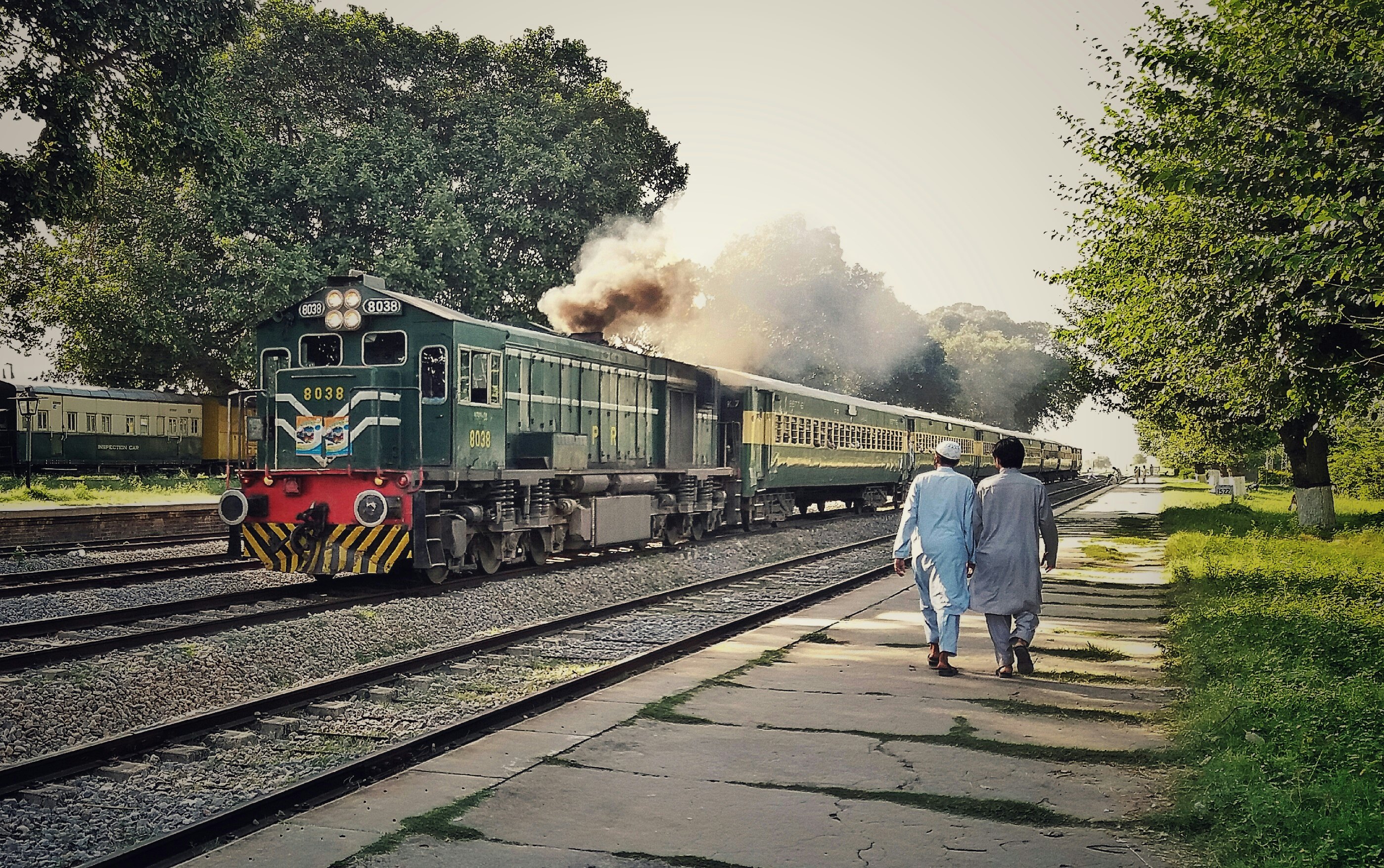
Ride the rails to meet the locals
The railway system in Pakistan was established during the period of British colonial rule, and the route of the main line of Pakistan Railways, stretching from Peshawar to Karachi, closely mirrors the path taken by Alexander the Great when he invaded in 327 BCE. Unfortunately, due to inadequate maintenance and investment, the trains have become outdated. Service does not always meet international standards and train derailments have occurred in the past.
However, train travel presents a wonderful chance to engage in meaningful interactions with local people, and a unique opportunity to enjoy the diverse beauty of the local landscape and culture. Taking the train is also an economical choice for travel in the south of the country – for example, from Islamabad/Rawalpindi or Lahore to Karachi.
Tickets can be booked online through the Pakistan Railway website if you have a local contact number and identity card. However, the online booking system is not very reliable – it's better to buy tickets at the railway station a few days before you travel. Several different classes of trains operate between the main destinations in Pakistan; for travel between Lahore and Karachi, Green Line Express and Pak Business Express trains are the superior choices.
Tickets for classes of travel can be reserved in advance. AC Standard Class (also known as AC Lower Class) provides a satisfactory seat in an air-conditioned carriage. If you'd prefer a little more comfort, AC Business or AC Sleeper Class is more suitable. Almost all trains also offer Economy category seats, which are affordably priced. However, this class of travel can be challenging due to overcrowding and uncomfortable seating in open-plan carriages. When traveling in AC class, booking a whole cabin (with space for up to 6 individuals) offers increased privacy for people traveling in a group.
At stations, food vendors hop on the trains selling local specialties or you can explore more dining options by taking a quick stroll along the station platform when the train stops. Just be mindful not to take too long – trains only halt for a few minutes at each station, and there’s usually a rush of passengers getting on or off with their luggage.
Fly to cut out slow overland journeys
Air travel presents a convenient alternative to long, slow trips overland, such as the journey from Islamabad or Lahore to Karachi, as well as for reaching Pakistan's mountainous regions. Pakistan International Airlines (PIA), the country's flagship carrier, has flights to destinations across Pakistan, including the mountain airstrips at Gilgit, Skardu and Chitral.
Complementing the national carrier, private airlines such as Air Blue operate flights to select destinations, with most flights starting in Karachi, Lahore and Islamabad. In recent years, several new airlines have commenced operations, including Serene Air, Air Sial and Fly Jinnah. Reserve tickets from the airlines' official websites, or through local travel agents.
Flights to mountainous regions should be booked months in advance; availability falls during the bustling tourist season from June to October, so last-minute bookings are not advisable. Domestic flights are often delayed, particularly during the foggy winter season in the plains. Additionally, flights to northern areas are prone to delays or cancellations during the monsoon season between July and September.
Buses and planes provide (relatively) easy access to the mountains
The Northern Area Transport Company (NATCO) is the most important bus service provider for travel to Gilgit-Baltistan. However, some of their buses are old and not adequately maintained, with limited legroom for a lengthy journey of over 20 hours on uneven roads.
Departing from Rawalpindi in the evening, Natco buses travel through the night to reach destinations in the mountains the following day. Ticket prices are moderate but the buses can be overcrowded and some play loud music throughout the journey. Consider traveling with a chartered vehicle and driver for more comfort.
Recently, Faisal Movers has started offering services to select destinations in Gilgit-Baltistan and Khyber Pakhtunkhwa. Their buses are in better condition, ensuring a more comfortable journey. For those planning a trip to the Chitral region, the Hindukush Express stands out as a dependable choice.
If you’re considering flying to the mountains, you'll find three primary airports receiving flights from the lowlands: Gilgit, Skardu and Chitral. The flights typically span about an hour – a significant reduction on the travel time by road – but it's important to note that these flights use small ATR aircraft and services are frequently impacted by weather conditions.
An upgrade has been made to Skardu airport recently, allowing for flights using larger Airbus aircraft. In 2023, Skardu Airport welcomed its inaugural international flight originating from Dubai, opening up a new, more direct route to the mountains.

Renting a car and driver gives you more flexibility
Renting a vehicle is the most comfortable way to travel around Pakistan, as it provides greater comfort and flexibility, and saves a lot of time. You’ll find agencies renting cars and 4WD vehicles all over Pakistan, and the majority offer vehicles with a driver, so you won’t have to worry about having the correct driving license or learning the local road rules.
Pakistan drives on the left side of the road but driving here can be challenging due to the chaotic traffic and inadequate road infrastructure – having an experienced local driver familiar with navigating the region is a definite advantage. Note that foreigners are required to present their passports and visas at police checkpoints when journeying through mountainous regions and in some southern parts of Pakistan. Carry printed copies of your passport and visa for easy access, as it will help to prevent any potential delays or complications.
If you're keen to explore side valleys in Gilgit-Baltistan and Khyber Pakhtunkhwa, a 4WD vehicle is essential for navigating the region’s unpaved roads. Among the perilous (but thrilling) roads in Pakistan’s mountains, the routes to the Fairy Meadows, Shimshal, Chapursan, Shandur Pass and Kalash stand out.
Be aware that certain high mountain passes become impassable in winter due to heavy snowfall, so don’t schedule a trip without checking which routes are accessible at the time of your visit. The Karakoram Highway is open year-round as far as the Chinese border, but the border crossing between Pakistan and China closes in winter, usually between November and March.
Renting motorcycles is easier, with a number of companies specifically catering to the needs of tourists, including Karakoram Bikers, which specializes in the Karakoram region. Rental companies recommend that riders have an International Driving Permit alongside a home driving license covering geared motorcycles, though license checks are not a frequent occurrence.
Navigating Pakistan's roads can be a challenging endeavor, and previous experience of motorcycle riding is essential for such adventures. Always drive cautiously and give way to larger vehicles. It's crucial to obtain appropriate insurance when you rent a motorcycle, as the majority of travel insurance providers do not include coverage as standard.
Understanding Pakistan’s road network
In the more developed regions of Pakistan, the road network is of a commendable standard. Surfaced roads connect the main cities, and roads within urban areas are well maintained. Major cities such as Karachi, Lahore and Islamabad are connected by modern motorways featuring up to six lanes.
This road system is undergoing rapid enhancement thanks to the China-Pakistan Economic Corridor (CPEC) initiative. The main objective of this project is to establish a direct connection between Gwadar Port in Balochistan and Kashgar in China for the movement of goods to international markets.
The legendary Karakoram Highway (KKH) between Pakistan and China was constructed along the path of the ancient Silk Route and it’s frequently hailed as the 8th wonder of the world because of the challenging terrain and breathtaking views.
Driving along this famous highway gives you the chance to marvel at the beauty of majestic mountains such as Nanga Parbat (8126m/21,660ft) and Rakaposhi (7788m/25,551ft), while you pass through three of the world's highest mountain ranges: the Karakoram, the Himalayas and the Hindukush.
Pakistan’s other signature route is the Grand Trunk (GT) Road, an ancient trading route that originates in Kabul in Afghanistan, spans large parts of Pakistan and India, and eventually reaches Bangladesh. Within Pakistan, the GT Road extends from the Khyber Pass in Peshawar to the Wahga border in Lahore.
The GT Road sees constant traffic, including Pakistan’s distinctively ornamented trucks and buses; a drive along this historic route will provide a mixture of awe and fascination, as you share the road with vibrantly adorned freight trucks showcasing Pakistan's renowned truck art. Traveling this route will also allow you to explore a series of spectacular historical landmarks dating back to the Mughal era.
Buses, taxis and rickshaws provide easy urban transport
You can't solely depend on public transportation to reach every corner of every city; instead, you'll need to mix various commuting methods. When moving around cities such as Lahore, Rawalpindi and Multan, government-run Metro Bus services are a reliable option. In Karachi, buses on the Green Line and Orange Line of the city’s Bus Rapid Transit (BRT) system serve key locations.
Alongside government-run bus services, there are numerous smaller bus companies operating within Pakistan’s cities, although the vehicles often lack proper upkeep and finding out details about routes and schedules can be challenging; ask locally for advice.
In urban areas, conventional taxis are available at taxi stands. However, negotiating a price is necessary as most taxis do not have meters. As an alternative in major cities, popular ridesharing apps include Careem, Uber (in Lahore) and InDrive.
For those seeking a more adventurous experience, simply embark on an enjoyable journey aboard one of Pakistan’s vibrantly ornamented autorickshaws and Qingqis (motorcycle rickshaws). As with taxis, you’ll have to negotiate a fare.
In Lahore, you’ll have the opportunity to discover the city via a guided tour on a double-decker sightseeing bus. For an enriching experience within Lahore’s old city walls, you can take a ride onboard the city’s colorful Rangeela rickshaws. These rickshaws, adorned with truck art themes, have become a popular attraction among tourists, and navigate fixed routes around the old city.

Travel to restricted areas in Pakistan
Certain regions in Pakistan remain off-limits to foreign visitors unless they first obtain a No Objection Certificate (NOC) – a time-consuming process known for its complexity. Officially restricted areas include Azad Kashmir, Balochistan, and a number of other border regions.
Travel advisories from foreign governments advise caution when journeying through some parts of Pakistan, and warn against “all travel” in some areas. If you ignore this government advice, your travel insurance may not be valid. It is imperative to thoroughly research and plan your travel itinerary, along with securing comprehensive insurance with coverage for all sections of your planned route within Pakistan.
Accessible travel in Pakistan
Infrastructure in Pakistan is primarily designed for those without mobility issues, and there is limited provision for travelers with disabilities. There are no dedicated cycle lanes and spaces for pedestrians are often shared with fast-moving vehicles, posing significant challenges for the mobility-impaired. Additionally, few streets and buildings offer accessibility modifications for wheelchairs and baby strollers, further limiting inclusivity.
Few travel agencies or transportation services specifically cater to individuals with disabilities, and traveling by bus or train can be difficult due to inadequate infrastructure for wheelchair users and travelers with limited mobility. Renting a private vehicle along with a driver is probably the best way to ensure a comfortable and flexible journey. For more information on accessible travel, see Lonely Planet’s Accessible Travel Resources.









